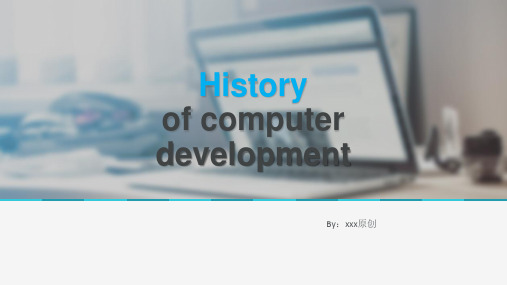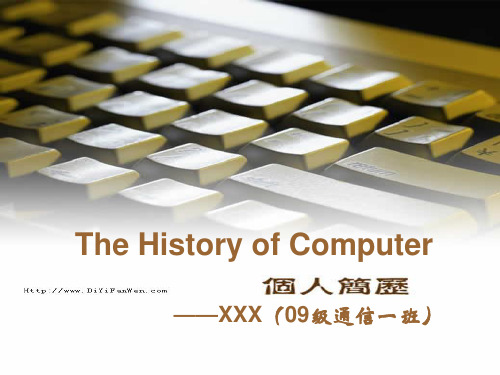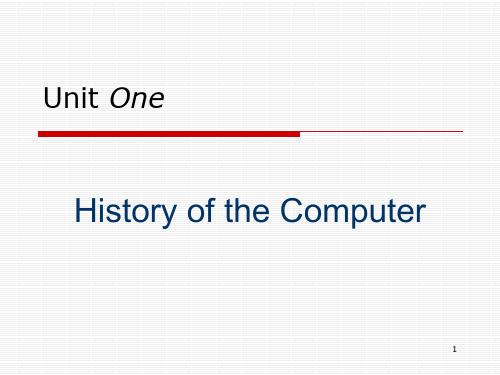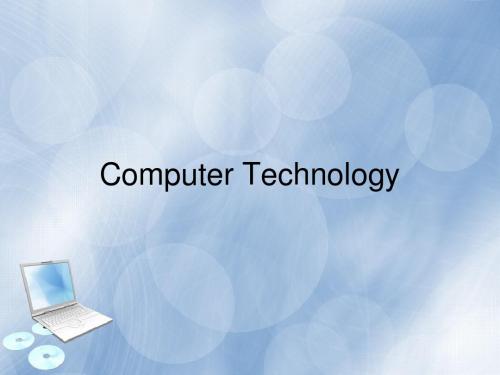计算机发展历史英文PPT The history of computer
计算机技术发展史(共15张PPT)

变。 1876至1878年:Baron Kelvin 制造了一部泛音分析机及潮汐预测
机。
但在1924 1937年:Alan
T年ur,ing改想名出为了In一ter个na“ti通on用al机B器us1(inU9ens0ivse4rs年al M:JMaocahhcinhnein)e”AC.Forlpe的omr概atii念nong,可取以得执(IB行M真任)。空何的二算法极,管形成的了专一个利“可权计算,为
111989697955年年年:::IGABTuMAg公RlieI司-lm-8研o80M制0a微成rc电功on脑9i0传问列送世卡广。片播机讯和号系。1896年M:aHc统oh-l-li3en计rei算tCh机o成系m统立p。a制ny表)。机器公司(Tabulating
1956年:IBM公司推出科学704计算机。 1901年:打孔键出现,之后的半个世纪只有很少的改
第五页,共15页。
1890—20世纪早期
1950年:"自动化"一词第一次用于汽车工业1。893年:第一部四功能计算器被发明。 11997411年年:2伊月利:Z诺us大e 学完设成计“V完3”(成后伊来利叫阿Z3克),IV是巨1第型8一计9部算5年机。:G操u作g中lie可l编m写o程M序a的r计c数on机i。传送广播讯号。
部与Leibniz相似的乘法计算器。
• 1786年,J.H.Mueller 设计了一部差分机,可惜没
有拨款去制造。
• 1801年, Joseph-Marie Jacquard 的织布机是
用连接按序的打孔卡控制编织的样式。
第四页,共15页。
1854年:George Boole 出版 “An Investigation of the Laws of Thought”,是讲述符号及逻辑理由,它后来成为计算机设计的 基本概念。
计算机发展史-英文版

Until the 17th century, computing devices have a second important step forward(计算设备有一个第二重要的一步).
In 1666, Samuel Morland(塞缪尔· 莫 兰德) who was English ,invented the addend and subtrahend machine (加数和减数机) .
1987: A supercomputer release,which can
made 200 million operations per second.
1987年:一个超级版本,它可以每秒
运算200万
At present, the type of computer has a lot of friends, according to the computer’s processing speed classification, It can be divided into five types:
The History of
computer development
5th century BC, Chinese invented the
abacus(算盘).
It is widely used in commercial trade (商业贸易), and this is the first calculation tool. It is also considered the prototype(原型) of a computer.
The real answer is that many inventors contributed to the history of computers. The development of computers reflects the wisdom of modern humans.
2024版计算机的发展历史ppt课件

机械计算机的诞生17世纪19世纪20世纪初1930年代1940年代030201电子计算机的雏形010204早期计算机的特点与局限体积庞大、功耗高、速度慢。
使用机器语言或汇编语言编程,编程效率低下。
存储容量有限,输入输出设备简陋。
可靠性差,维护成本高。
03真空管计算机的原理与结构真空管作为电子开关真空管利用电子在真空中的运动实现开关功能,从而控制电流的通断。
二进制运算真空管计算机采用二进制数制进行运算,通过逻辑电路实现基本的算术和逻辑操作。
庞大而复杂的结构真空管计算机由大量的真空管、电阻、电容等电子元件组成,体积庞大且结构复杂。
代表性机器:ENIAC与UNIVACENIAC(电子数值积分计算机)ENIAC是世界上第一台通用电子计算机,于1946年在美国宾夕法尼亚大学诞生。
它使用了17468个真空管,占地170平方米,重达30吨,每秒可进行5000次加法运算。
UNIVAC(通用自动计算机)UNIVAC是第一台商用电子计算机,由美国雷明顿兰德公司推出。
它采用了更为先进的电路设计,提高了运算速度和可靠性,被广泛应用于军事、科研和商业领域。
军事应用商业应用对后世计算机发展的影响科学研究真空管计算机的应用与影响晶体管计算机的原理与结构晶体管原理计算机结构采用晶体管逻辑电路,实现了计算机的运算器、控制器、存储器等主要部件,提高了计算机的可靠性和性能。
代表性机器IBM 7090CDC 6600晶体管计算机的应用与影响应用领域对后世影响集成电路计算机的原理与结构集成电路技术微处理器出现计算机体系结构代表性机器Apple IIntel 4004由史蒂夫·沃兹尼亚克设计,采用Intel 8080微处理器,是第一台个人电脑的雏形。
机器特点集成电路计算机的应用与影响应用领域对社会的影响对计算机产业的影响大规模集成电路计算机的原理与结构大规模集成电路技术01计算机体系结构02指令系统03代表性机器IBM PCMacintosh互联网革命随着计算机网络技术的发展,大规模集成电路计算机成为互联网的基础设施,推动了互联网革命的爆发。
History of computer development计算机发展史ppt

Babbage's Difference engine巴贝奇差分机
First general-purpose computing device The Engine incorporated an arithmetic logic unit, control flow in the form of conditional branching and loops, and integrated memory, making it the first design for a general-purpose computer that could be described in modern terms as Turing-complete
The addend and subtrahend machine
In 1668, Samuel Morland who was English ,invented the addend and subtrahend machine. Sir Samuel Morland , of England, produces a non decimal adding machine, suitable for use with English money. Instead of a carry mechanism, it registers carries on auxiliary dials, from which the user must re-enter them as addends.
The future development trend of computer
The development of computer technology has the following four characteristics : 1. multi-polarization(多极化) 2. Intelligent(智能化)
计算机发展历史英文PPT The history of computer.

——XXX(09级通信一班)
• Nearly 5,000 years ago the abacus emerged in Asia Minor. The abacus may be considered the first computer. This device allowed its users to make computations using a system of sliding beads arranged on a rack. Early shopkeepers used the abacus to keep up with transactions. The use of pencil and paper spread, the abacus lost its importance.
6、The PDP—8 is generally recognized as the most important small computer of the 1960's .
7、Interface Message Processor (IMP)
8、The first commercially available personal computer——Kenbak-1
• It wasn't until 1820, however, that mechanical calculators gained widespread use. A Frenchman invented a machine that could perform the four basic mathematic functions.
• In 1642, Blaise Pascal, the 18-year-old son of a French tax collector, invented what he called a numerical wheel calculator to help his father with his duties. In 1694, a German mathematician and philosopher improved the Pascaline by creating a machine that could also multiply.
计算机发展史PPT课件

关注P2P- 回顾计算机的发展史
• 最早关注P2P是因为Groove,这个新的基于
P2P的协作工具。当时看了Groove以及相关 介绍以后,特别是Ray Ozzie的介绍后,相 当吃惊。于是给公司里的讨论组发了一封 信:建议大家试一下并保持关注,Groove 有可能会是微软的一个潜在的竞争。当然 这个预言没有变成现实,一年多以后, Groove被微软收购,Ray Ozzie一起进入微 软。
苹果电脑的传奇发展史
1987年,苹果发布其Mac II,功能强大的家用计算机,
月销售达到5万台。苹果又过了几年好日子。
1991年苹果电脑的操作系统是Mac OS,但其与流行的兼
容机软硬件不兼容。这大大束缚了它的发展,让它吃尽了苦
头,微软的操作系统很快占领了广大的市场。
1994年苹果发布其家用机PowerMac。第一台基于IBM和
• 1911年,荷兰物理学家
Kamerlingh Onnes 在 Leiden Unversity 发现超导电。
计算机的发展
1977年,苹果--II型微电脑诞生。 1978年,超大规模集成电路开始应用。 1979年,夏普公司宣布制成第一台手提式微 电脑。 1982年,微电脑开始普及,大量进入学校和 家庭。 1984年,日本计算机产业着手研制“第五代计 算机"---具有人工智能的计算机。
关注P2P- 回顾计算机的发展史
• 看P2P, 就好像在看一个计算机的发展史:很多年
以前,统治世界的是大型机,提倡的是中心化的 应用,所有应用都是在主机完成,于是有分时操 作系统的产生,于是有了IBM创始人老沃森的断 言:全球对于个人电脑的需求量不会超过5台!我 们现在都知道,这是一个可笑的预言。大型机的 主导不是必然的,当时有这样的情况,只是因为
计算机发展史ppt课件模板

微处理器是计算机发展的重要里程碑,它使得 计算机能够更快速、更高效地处理信息。
计算机的发展历史
计算机的发展经历了从概念到现代演变的 过程,包括硬件和软件的不断革新。
数据支撑
根据国际数据公司(IDC)的报告, 2019年全球计算机市场规模达到了3.5 万亿美元,预计到2024年将增长到4.6 万亿美元。
第一代计算机的特点与应用
计算机的发明
第一代计算机的特点
第一代计算机的应用
现代计算机的发展
第二代计算机的发展与进步
计算机工 作原理
二进制数
逻辑运算
二进制
信息处理
计算机发 展
存储技术
存储技术
数据存储 速度和容
量
固态硬盘
02
计算机的现代演变历程
The Modern Evolution of Computers
数据库系统的创新与应用
计算机的诞生 1946年,美国宾夕法尼亚大学教授艾伦·图灵提出了“图灵机”概念,标 志着计算机科学的诞生。 计算机的发展 从单电子计算机到超级计算机,计算机技术经历了几十年的快速发展,从 最初的二进制计算到如今的人工智能和量子计算。 数据库系统的创新 数据库系统从最初的关系型数据库到现在的NoSQL数据库,以及分布式数 据库等,不断在数据存储、查询和处理等方面进行创新。 数据库系统的应用 数据库系统广泛应用于企业、政府、教育等领域,如金融、医疗、教育等, 为各行各业提供了强大的数据处理能力。
04 .
计算机软件的历史演进
01
计算机的诞生与早期发 展
The Birth and Early Development of Computers
图灵机的提出与影响
the history of computerPPT课件

主语、谓语、宾 语
2
大连理工大学出版社
Passage One
The Introduction of ENIAC
Electronic computer was one of the greatest inventions in the 20th century. Once talking about computer, we have to think of the born of ENIAC(Electrical Numerical Integrator And Calculator)( Pic 1.1).
trajectory tasage One
The Introduction of ENIAC
ENIAC used 18,000 vacuum tubes, about 1,800 square feet of floor space, weighed 30 tons and consumed about 180,000 watts of electrical power. It had punched card I/O, 1 multiplier, 1 divider/square rooter, and 20 adders using decimal ring counters, which served as adders and also as quick-access (0.0002 seconds) read-write register storage. The executable instructions making up a program were embodied in the separate “units” of ENIAC, which were plugged together to form a “route” for the flow of information.
计算机的发展历史ppt.

• 1983年:1月,苹果公司推出了研制费 用高达5000万美元的丽萨(Lisa)电脑 ,这也是世界上第一台商品化的图形用 户界面的个人计算机,同时这款电脑也 第一次配备了鼠标。
• 5月8日,IBM推出了IBM PC的改进型号 IBM PC/XT,并为其内置了硬盘。
• 1985年:Philips和Sony合作推出CDROM驱动器。
• 1974年:4月1日,Intel推出了自己的第 一款8位微处理芯片8080。
• 12月,电脑爱好者爱德华.罗伯茨( E.Roberts)发布了自己制作的装配有 8080处理器的计算机“牛郎星”,这也 是世界上第一台装配有微处理器的计算 机,从此掀开了个人电脑的序幕。
1975年:克雷完成了自己的第一个超级计算机“克雷一号”( CARY-1),实现了每秒一亿次的运算速度。该机占地不到7平方米 ,重量不超过5吨,共安装了约35万块集成电路,同时这也标志着
1946年,世界上第一台计算机诞生于美国宾夕 法尼亚大学,它的名字叫“埃尼阿克”(ENIAC)
这是一个由18000个 像小 灯泡一样大的电子
管组成的庞然大物,它的 总体积约90立方米,重达 30吨,占地170平方米,需 要用一间30多米长的大 房间才能存放, 它不仅 体积大.重量重,用电多, 造价高,可靠性差,而且 只有专家才能使用它.
第一课 计算机基础
电子计算机(computer),简称计算机,俗称电脑,是20世纪 人类最伟大.最卓越的科技成就之一.
[史前时代:1623——1895]
• 1623年:德国科学家契克卡德( W. Schickard)制造了人类有史以来第一 台机械计算机
1642年:法国科学家帕斯卡(B.Pascal)发明了著名 的帕斯卡机械计算机,首次确立了计算机器的概念。
2024年度-《计算机的发展史》PPT课件

计算机结构
晶体管计算机采用中央处理器 (CPU)为核心的结构,包括运算 器、控制器、存储器和输入输出设 备等组成部分。
逻辑电路
晶体管计算机使用逻辑电路实现各 种逻辑运算,如与、或、非等,进 而实现复杂的计算和控制功能。
14
第二代计算机的代表作品
1 2 3
IBM 7094 IBM公司在1960年代推出的晶体管计算机,具有 高性能和稳定性,被广泛应用于科学计算、数据 处理等领域。
随着企业信息化的发展,晶体管计算机被广 泛应用于数据处理领域,如财务管理、库存 管理、人事管理等。
军事应用
社会影响
晶体管计算机在军事领域的应用也日益广泛, 如导弹控制、雷达信号处理等。
晶体管计算机的出现推动了计算机技术的飞 速发展,改变了人们的生活方式和工作方式, 对社会产生了深远的影响。
16
04
命性的用户界面和多媒体功能。
23
超大规模集成电路计算机的应用与影响
个人计算机的普及
超大规模集成电路计算机的出现,使得个人计算机的价格逐 渐降低,性能逐渐提高,成为家庭和办公的必备设备。
互联网的发展
超大规模集成电路计算机为互联网的兴起提供了强大的技术 支持,使得人们可以通过网络进行信息交流和资源共享。
多媒体技术的应用
超大规模集成电路计算机支持音频、视频等多媒体数据的处 理和应用,推动了多媒体技术的快速发展。
人工智能的崛起
超大规模集成电路计算机为人工智能提供了强大的计算能力 和数据存储能力,使得人工智能得以快速发展和应用。
24
06
计算机的发展趋势与展望
25
计算机硬件的发展趋势
处理器性能提升
随着制程技术的不断进步,处理器性能将持续提升,同时功耗将 进一步降低。
关于computers知识的英语PPT

LENOVO
• Lenovo Group Limited is the world's fourth largest personal computer manufacturer after Hewlett-Packard and Dell of the U.S. In 2005, it purchased IBM's PC division. • Lenovo produces desktops, laptops, servers, handheld computers, imaging equipment, and mobile phone handsets. Lenovo also provides information technology integration and support services, and its QDI unit offers contract manufacturing.
Dell
• Dell Computer was founded as PC's Limited in 1984 by university student Michael Dell. Selling assembled computers from his dormitory room, Michael abandoned the university during the planning stage of his first in-house computer design in 1985. The company was so successful that within two years PC's Limited had distribution offices in Europe, and changed it's name to Dell Computer Corporation. By 1991, seven years after selling it's first computer, Dell Computer Corporation was listed in the Fortune 500.
计算机发展史-英文

计算机发展史-英文The History of ComputersComputers have become an indispensable part of our lives today, revolutionizing the way we work, communicate, and access information But have you ever wondered how they came to be? The development of computers is a fascinating journey that spans several decades and is marked by significant technological advancementsThe earliest form of computing can be traced back to ancient times when humans used simple tools like the abacus for arithmetic calculations The abacus, with its rows of beads, allowed for basic addition, subtraction, multiplication, and division However, it was a far cry from the complex and powerful machines we have todayIn the 19th century, mechanical calculators began to emerge These devices were operated by turning cranks or pulling levers and could perform more complex calculations than the abacus They were used mainly in offices and businesses to handle large amounts of numerical dataThe 20th century witnessed a significant leap in computing technology The first electronic computers were developed during World War II for military purposes These early computers were huge, taking up entire rooms and consuming a massive amount of power They were based on vacuum tubes, which were bulky, unreliable, and generated a lot of heatOne of the most important milestones in the history of computers was the invention of the transistor in 1947、 Transistors replaced vacuum tubes and were much smaller, more reliable, and consumed less power This led to the development of smaller and more efficient computersIn the 1960s, integrated circuits were introduced, which further miniaturized the components of a computer This allowed for the creation of desktopsized computers that were more accessible to businesses and individualsThe 1970s saw the birth of the microprocessor, a single chip that contained the processing power of an entire computer This innovation made it possible to develop personal computers that were affordable and practical for home use Companies like Apple and IBM played a crucial role in bringing personal computers to the mainstreamThe 1980s and 1990s were marked by rapid advancements in software and operating systems Graphical user interfaces (GUI) made computers more userfriendly, and applications such as word processors, spreadsheets, and games became widely available The Internet also began to gain popularity during this time, connecting computers around the world and opening up a whole new realm of possibilitiesThe 21st century has brought about even more revolutionary changes Laptops, tablets, and smartphones have become ubiquitous, allowing us to carry computing power in our pockets and access information anytime, anywhere Cloud computing has enabled us to store and access data remotely, eliminating the need for large local storage devicesAdvancements in artificial intelligence and machine learning are also shaping the future of computing Computers are now able to perform tasks that once required human intelligence, such as image recognition, language translation, and autonomous drivingLooking back at the history of computers, it's clear that the progress has been nothing short of remarkable From the simple abacus to the supercomputers of today, the development of computing technology has transformed our world in ways that were once unimaginable And the journey is far from over As technology continues to evolve at an astonishing pace, we can only anticipate more exciting innovations and breakthroughs in the field of computing in the years to comeThe impact of computers on society has been profound They have changed the way we do business, communicate with each other, and access education and entertainment In the business world, computers have streamlined operations, increased productivity, and enabled global collaboration Online shopping, ecommerce, and digital marketing have become integral parts of the modern economyIn the field of communication, email, social media, and video conferencing have made it easier than ever to stay in touch with people around the world We can now communicate instantly and share information with a click of a buttonEducation has also been transformed by computers Online courses, educational software, and digital libraries have made learning more accessible and personalized Students can now access a vast amount of knowledge and resources from the comfort of their homesHowever, the rapid development of computers has also brought some challenges Issues such as cyber security, privacy concerns, and digital divide need to be addressed Cyber attacks and data breaches pose a threat to personal and corporate information The unequal access to technology and the digital skills gap are also issues that need to be overcome to ensure that the benefits of computing are shared by allIn conclusion, the history of computers is a story of continuous innovation and progress It is a field that has constantly pushed the boundaries of what is possible and has had a profound impact on every aspect of our lives As we look forward to the future, it is exciting to think about the new possibilities and challenges that lie ahead。
电脑发展历史PPT课件

1944年 首台自动按序控制计算器——Mark Ⅰ ●Mark Ⅰ——自动按序控制计算器 Howard H. Aiken完成"ASCC Mark I”(自动按序 控制计算器 Mark I ,Automatic Sequence -Controlled Calculator Mark I),亦称“Haward Mark I”。这部机器有51尺长,重5顿,由 750,000 部份合并而成。它有72个累加器,每一个有自己的算术 部件,及23位数的寄存器。
第2页/共30页
• 1642年 计算机雏形——Pascaline(加法器)
第3页/共30页
1642年 计算机雏形——Pascaline(加法器)
●Pascaline(加法器) 1642年,法国哲学家兼数学家布累斯 ·巴斯柯
(Blaise Pascal)发明了第一台真正的机械计算器—— 加法器全名为滚轮式加法器,当初发明它的目的是为了 帮助父亲解决税务上的计算。其外观上有6个轮子,分 别代表着个、十、百、千、万、十万等。只需要顺时针 拨动轮子,就可以进行加法,而逆时针则进行减法。原 理和手表很像,算是计算机的开山鼻祖了。 (Pascaline)。
第22页/共30页
•1642年 计算机雏形——Pascaline(加法器) •1833年 首款试图建立数字化的计算机 •1931年 电子计算机的先驱——微分分析仪 •1938年 首台采用继电器工作的计算机——Z1 •1942年 首台真空管计算机——ABC •1943年 首台可编程计算机——COLOSSUS •1944年 首台自动按序控制计算器——Mark Ⅰ •1946年 ENIAC I——电子数字积分计算器 •1949年 第一台存储程序计算机——EDSAC •1951年 首台实时可交互式电脑——Whirlwind Ⅰ •1952年 现代电脑之父的完美理念——IAS
《计算机的前世今生》PPT课件

光子计算机
与传统硅芯片计算机不同,光计算机用光束代替电子进行计算和存储:它以不同波长的光代表不 同的数据,以大量的透镜、棱镜和反射镜将数据从一个芯片传送到另一个芯片。
这两篇报告的综合设计思想,便是著名的“冯·诺依曼结构(von Neumann Architecture)”。报告明确指出: 采用二进制,不但数据采用二进制,指令也采用二进制; 计算机由5部分构成:运算器、控制器、存储器、输入和输出装置; 程序由指令组成并和数据一起存放在存储器中,机器按程序指定的逻辑顺序,把 指令从存储器中读出来并逐条执行,从而自动完成程序描述的处理工作。(即,“存 储程序”思想)
下一代计算机
随着计算机技术的发展,它已经成为我们工作上的工具,生活中的控制中心是必然的事情 。计算机的未来充满了变数。性能的大幅度提高是不可置疑的,而实现性能的飞跃却有多 种途径。不过性能的大幅提升并不是计算机发展的唯一路线,计算机的发展,还应当变得 越来越人性化,同时也要注重环保等等。 基于集成电路的计算机短期内还不会退出历史舞台。但一些新的计算机正在跃跃欲试地加 紧研究,这些计算机是:超导计算机、纳米计算机、光计算机、DNA计算机和量子计算机 等。
第五代电子计算机
从20世纪80年代开始,日本、美国、欧洲等发达国家都宣布开始新一代计算机的研究。人们普遍 认为新一代计算机应该是智能型的,它能模拟人的智能行为,理解人类自然语言,并继续向着微 型化、网络化发展。综合起来大概有以下几个研究方向。
• 人工智能计算机 • 巨型计算机 • 多处理机 • 激光计算机 • 超导计算机 • 生物晶体计算机(DNA计算机) • 量子计算
- 1、下载文档前请自行甄别文档内容的完整性,平台不提供额外的编辑、内容补充、找答案等附加服务。
- 2、"仅部分预览"的文档,不可在线预览部分如存在完整性等问题,可反馈申请退款(可完整预览的文档不适用该条件!)。
- 3、如文档侵犯您的权益,请联系客服反馈,我们会尽快为您处理(人工客服工作时间:9:00-18:30)。
• The real beginnings of computers began with an English mathematics professor. His steampowered—Engine outlined the basic elements of a modern general purpose computer .
• It wasn't until 1820, however, that mechanical calculators gained widespread use. A Frenchman invented a machine that could perform the four basic mathematic functions.
• In 1889, an American inventor created a machine that used cards to store data information which was fed into a machine and compiled the results mechanically. Each punch on a card represented one number, and combinations of two punches represented one letter. He brought his punch card reader into the business world, founding Tabulating Machine Company in 1896, later to become International Business Machines (IBM) in 1924 .
When World War II began, the governments sought to develop computers to accomplishment their potential strategic importance. This increased funding for computer development projects ……
The History of Computer
——XXX(09级通信一班)
• Nearly 5,000 years ago the abacubacus may be considered the first computer. This device allowed its users to make computations using a system of sliding beads arranged on a rack. Early shopkeepers used the abacus to keep up with transactions. The use of pencil and paper spread, the abacus lost its importance.
• In 1642, Blaise Pascal, the 18-year-old son of a French tax collector, invented what he called a numerical wheel calculator to help his father with his duties. In 1694, a German mathematician and philosopher improved the Pascaline by creating a machine that could also multiply.
6、The PDP—8 is generally recognized as the most important small computer of the 1960's .
7、Interface Message Processor (IMP)
8、The first commercially available personal computer——Kenbak-1
9、In 1976,the first Apple computer was born.
10、The first true portable computer—— Osborne 1
3、In 1960, Nippon Electric Company invented NEAC 2203
4、In 1964, IBM System/360 was born…
5、The CDC 6600 was born in 1964 which
is considered the first supercomputer
The next 10 inventions are the milestones on the development of computer……
• 1、The Electronic Numerical Integrator and Computer (ENIAC)
2、The Semi-Automatic Ground Environment (SAGE) was an automated control system for tracking and intercepting enemy bomber aircraft.
